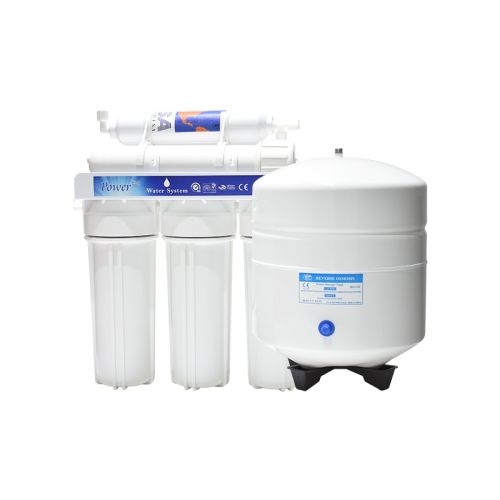
- Home
- Home & Living
- Kitchen, Dining &...
- Water Coolers & ...
- 5 stage revers osmos...
Brand:
Aqua Care
R3,600.00
Inclusive All Taxes
This Product Is Sold By cleardrops To Ask A Question, Click Ask A Question Below
Seller
cleardrops
-
0
-
1 Days Warranty
-
Shippment And Pickup
Description
Domestic Reverse Osmosis Purification Systems
If you’re looking for a water filter that will provide outstanding drinking water for your home or small business, then the Reverse Osmosis (RO) Water Purification System is one of the most popular and best water filtration methods available and is one of the most complete under the counter system on the market. The Reverse Osmosis Water Purification System will most definitely become your most favorite kitchen appliance. No other solution offers the same healthy benefits like clean fresh water that you will get from your Reverse Osmosis Water System, you can be rest assured that your drinking water is clean, clear and healthy.
The system eliminates up to 99.8% of harmful contaminants in water such as bacteria, viruses, arsenic, radium, lead and chlorine thanks to the multi-stage filtration technology. In simple terms, Reverse Osmosis works as water is forced across a semi-permeable membrane, leaving contaminants behind that are flushed down the drain. The clean drinking water collects in a holding tank.
The Reverse Osmosis Membranes used in our systems offers you one of the highest contaminant removal rates, enabling the system to produce the cleanest and clearest water possible. With the mere press of a level, you can enjoy an endless supply of the most refreshing and cleanest water in the comfort of your own kitchen.
Typical Rejection Characteristics of Reverse Osmosis Membranes
Arsenic – 92-96%
Barium – 95-98%
Cadmium – 95*98%
Calcium – 94-98%
Chloride – 85-92%
Cyanide – 84-92%
Fluoride – 84-92%
Iron – 94-98%
Lead – 95-98%
Manganese – 94-98%
Magnesium – 94-98%
Mercury – 95-98%
Nickel – 96-98%
Nitrate – 60-75%
Phosphate – 96-98%
Potassium – 85-95%
Selenium – 94-96%
Sodium – 85-94%
Sulfate – 96-98%
Zinc – 96-98%
Some Advantages of using Reverse Osmosis:
Friendly to the environment.
Filtration is fully automated.
Produces great purified water taste and is effective and safe.
Helps remove harmful bacteria and viruses in your municipal and borehole water systems up to 99.8%.
Removes dissolved minerals and other contaminants that cause water to smell unpleasant, taste poor and take on unusual colors.
Removal of dissolved minerals, metals and other particles benefits plumbing systems (There is nothing in the water to corrode pipes or collect as sediment).
Reverse Osmosis (RO) Systems Differ in Three Basic Ways:
There are may different Reverse Osmosis System on the market, while on system may look like the next in terms of the design and components, the can be substantial differences between systems.
Number of stages or filters.
Amount of water that can be filtered or produced each day (this amount is in "gpd” or gallons per day).
Quality of their components.
Reverse Osmosis Drinking Water Systems Are Easy To Maintain And Upkeep Costs Are Minimal.
Reverse Osmosis Membranes and Filters will need to be replaced every 6 months to 2 years depending on the type of filter, your feed water quality and water usage volume.
Replacement Filters for a basic 5 Stage Reverse Osmosis Unit
Stage 1 – 5 micron Sediment Filter (10Inch RO Sediment Filter) – Recommended Filter Change – Every 6 Months
The Sediment Filter removes visible particles such as rust, mud, dirt and any other floating particles from the water.
Stage 2 – Granular Activated Carbon Filter (10Inch RO GAC Filter) – Recommended Filter Change – Every 6 Months
The Granular Activated Carbon Filter will remove chlorine or organic molecules, which can cause bad taste and smells, that may be in the water.
Stage 3 – Carbon Block Filter (10Inch RO CTO Filter) – Recommended Filter Change – Every 6 Months
The Carbon Block filter is the next in line defense for any chlorine of organic molecules which might have got through from the 2nd stage. It also has a 5 micron filter ability to catch any carbon that might have broken off the 2nd stage.
Stage 4 – Reverse Osmosis Membrane (50GPD / 75GPD / 100GPD / 150GPD / 200GPD / 400GPD / 600GPD RO Membrane) – Recommended Filter Change – Every 2 – 3 Years
The Reverse Osmosis Membrane is the filter that removes and purifies the water from any impurities that is not visible to the human eye, such as pesticides, bacteria, herbicides, viruses, parasites and traced metals. The membrane is continually flushing to prevent blockage and a build-up of bacteria on the membrane which results in waste water.
Stage 5 – Taste and Odor Filter (10Inch RO Post Filter) – Recommended Filter Change – Every 12 Months
As you may have guessed, the Taste and Odor Filter removes any remaining molecules that may cause a bad taste or smell to the water
Offer to Buyer
we do installation contact us for pricing
Rating & Reviews
0
Based on 0 Ratings
-
5 Star
-
4 Star
-
3 Star
-
2 Star
-
1 Star
We use cookies to improve your experience. Read More
Accept Cookies



